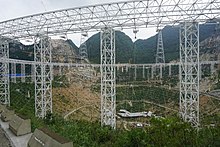Final panel added to China's FAST radio telescope
Wednesday, July 6, 2016

Image: Psr1909.
On Sunday, China announced the attachment of the final panel to its telescope named Five hundred meter Aperture Spherical Telescope (FAST). This piece marks the end of a five-year-long US$180 million (CNY¥1.2 billion) construction project.
FAST comprises about 4,500 panels and spans a diameter of 500 meters (about 1640 feet). The telescope is part of a series of ventures into space exploration by China, including planning another robotic Moon mission and creating a Chinese space station, with its core module set to be launched into space in 2018. With the country's founding centenary coming in 2049, Chinese President Xi Jinping said during a Beijing conference, "great scientific and technological capacity is a must for China to be strong".
In order to achieve optimal electromagnetic performance for FAST with minimal signal interference, it was built in the South China Karst. This ultimately forced the relocation of about 9,100 inhabitants within a 3.1-mile (5km) radius of the telescope. The residents received about US$1,800 (CNY¥12,000) in reimbursement, with those experiencing difficulties with housing receiving about US$1,500 (CNY¥10,000) in extra compensation. The Chinese government supports the resettlement, with senior party official Li Yuecheng saying the relocation would provide a "sound electromagnetic wave environment".
The telescope is now the largest-diameter single-dish radio telescope. It took the spot from the 305-meter diameter Arecibo Observatory telescope in Puerto Rico. Russia's RATAN-600 multi-element radio telescope has a diameter of 576 meters. This adds to China's record-defying achievements; it contains the world's largest bridge and the world's longest wall, the Great Wall of China.
The telescope is set to be ready for use in September. Its possible uses include exploration for pulsars, a special type of neutron stars detected through their emission of radio pulses. Scientists have also described the telescope's potential to explore alien civilization, with NAO Radio Astronomy Technology Laboratory director Peng Bo saying FAST's "potential to discover an alien civilization will be 5 to 10 times that of current equipment, as it can see farther and darker planets".
Sources
- Samantha Cole. "China Finishes Contruction On Its Giant Alien-Hunting Telescope" — Popular Science, July 5, 2016
- Neel V. Patel. "China Has Built the World's Largest Alien-Hunting Telescope" — Inverse (website), July 5, 2016
- "China fits final piece on world's largest radio telescope" — BBC News Online, July 4, 2016
- Charlie Campbell. "China to Hunt for Alien Life With World’s Biggest Radio Telescope" — Time (magazine), July 4, 2016
- Katie Hunt, Euan McKirdy. "China to uproot 9,100 residents to make way for giant space telescope" — CNN, February 16, 2016
- Fraser Cain. "What is a Pulsar?" — Universe Today, December 23, 2015
- Euan McKirdy. "China looks to the stars with creation of world's largest radio telescope" — CNN, October 12, 2015
- Kaushik. "RATAN-600, The World’s Largest Radio Telescope" — Amusing Planet, July 29, 2015
- "Longest bridge over water (aggregate length)" — Guinness World Records, July 6, 2016 (date of access)
- "Longest wall" — Guinness World Records, July 6, 2016 (date of access)


